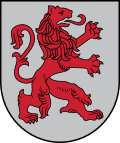This is a list of current coat of arms of Latvia, its historical lands, state cities, and municipalities.
Contents
- National
- Historical Lands
- State cities (with independent government)
- Municipalities
- Historical
- National 2
- Counties (until 1949)
- See also
- References
The present coats of arms of Latvia are regulated under the State Heraldic Commission (Valsts heraldikas komisija), the national heraldic authority under the President since 14 February 1994, which traced to the Heraldic Commission of the Latvian SSR from November 1988, and the Regulations on the Procedure for Renewal and Approval of Municipal Historic Coats of Arms in the Latvian Soviet Socialist Republic issued in February 1989 that intended to restore pre-Soviet coats of arms in Latvia. [1] [2] [3]






































































